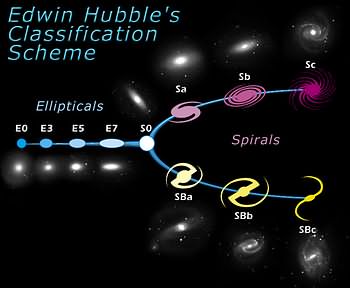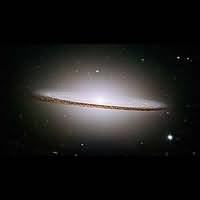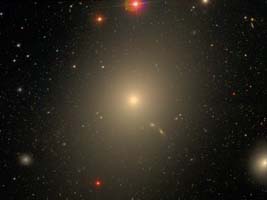Sidebar: Classifying Nebulae
The first step to understanding many different phenomena can often be to classify them. To this end, Hubble looked at a large sample of galaxy images and classified them according to their features. The general classifications he used were: spiral, elliptical and irregular. However, each main classification also had sub-classes based on other similarities.
Hubble's classification is often depicted in a diagram called the "Hubble Tuning Fork". Hubble proposed that this classification scheme may have been an evolutionary sequence for galaxies – that galaxies may evolve from one type to another throughout their lifetimes. Today, this classification scheme is viewed as overly simplistic and the evolution of galaxies is far more complex. However, Hubble's classifications were the first step in understanding galaxy formation and structure, and the classifications are often still used to describe galaxies.

Illustration of Hubble's classification scheme, often called the Hubble Tuning Fork. More information available here.
Image credit: NASA
Spiral Galaxies
Perhaps the best-known type of galaxy is spiral galaxies. These include those where the spiral arms are clearly visible, such as M 31 pictured below:

This is a composite image of the "grand-design" spiral galaxy M 81. More information available here.
Image credit: Hubble data: NASA, ESA, and A. Zezas (Harvard-Smithsonian Center for Astrophysics); GALEX data: NASA, JPL-Caltech, GALEX Team, J. Huchra et al. (Harvard-Smithsonian Center for Astrophysics); Spitzer data: NASA/JPL/Caltech/Harvard-Smithsonian Center for Astrophysics.
However, spirals encompass a larger range than just those for which we can see the spiral arms. One way to think of a spiral type galaxy is a galaxy with a central bulge and a disk. The spiral arms are contained within the disk of the galaxy. If we observe such a galaxy edge-on, we don't see the spiral arms. Here is an example of an edge-on spiral galaxy:

The Sombrero Galaxy is a spiral galaxy where we are observing the disk edge-on. The dark line through the galaxy is actually the disk. More information available here.
Image Credit: NASA and The Hubble Heritage Team (STScI/AURA).
In addition, about half of the spiral galaxies have a bar-like structure in the central bulge of the galaxy.

NGC 1300 is a classic example of a spiral galaxy with a "bar" in the central bulge. More information available here.
Image Credit: Credit: NASA, ESA, and The Hubble Heritage Team (STScI/AURA)
Hubble sub-classified spiral galaxies based on a combination of how tightly the spiral arms appeared to be wrapped around the bulge and the relative size of the bulge compared to the disk. Type Sa galaxies (spiral, sub-type a) have large bulges and are tightly wrapped, while type Sc galaxies have small bulges and loosely wrapped arms. The barred spiral galaxies are similarly sub-classified.
Ellipticals
Elliptical galaxies are those that appear, well, elliptical. The shape of an elliptical galaxy can appear to be anywhere from perfectly round to cigar shaped. Hubble sub-classified elliptical galaxies based on their "ellipticity" which is defined as 10 times the eccentricity. Or:


Two types of elliptical galaxies. The image on the left is M 87, an elliptical that appears nearly circular and is classified as an E0 galaxy in the Hubble classification scheme. The image on the right is M 101, an elliptical that appears more elongated and is classified as an E5 galaxy in the Hubble classification scheme.
Image credits: Both images are from Jarrett et al., Astronomical Journal 125, 525 (2003).
It should be noted that the apparent shape of an elliptical galaxy in the sky is more dependent on our line-of-sight to that galaxy than any intrinsic properties of the galaxy itself. If a galaxy were intrinsically cigar shaped, and we viewed it edge-on, it would appear circular.
Irregular Galaxies
Hubble found that not all galaxies fell neatly into the "spiral" or "elliptical" categories. They don't show obvious spiral structure, nor do they show a central bulge, so they are not spiral galaxies. In addition, they lack symmetry, so are not elliptical galaxies. These hard to classify galaxies were lumped into a separate category – irregular galaxies.

NGC 1427A is an example of an irregular galaxy. It does not have any hint of spiral structure, a bulge or symmetry. In fact, this image, from the Hubble Space Telescope, shows that this galaxy is falling headlong into the Fornax galaxy cluster, and will not survive long as a recognizable galaxy. More information available here.
Image credit: NASA, ESA, and The Hubble Heritage Team (STScI/AURA).



